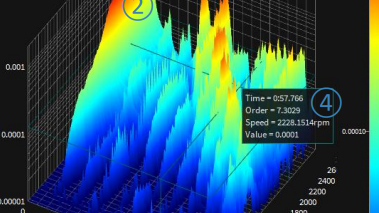Latest Oxygen 7.6 Update
Choosing The Optimum Mounting
Surface Preparation
For optimal performance, particularly at high frequencies, it is advisable to have smooth, flat, and uncontaminated surfaces on both the accelerometer base and the test object. Scratches or burrs should be avoided. If the accelerometer base becomes scratched, it can be smoothed using a lapping plate. If lapping is not an option, other machining techniques such as grinding, spot facing, milling, or turning can be used to create suitable flat surfaces for mounting.
Furthermore, it is crucial to establish a sturdy mechanical connection between the vibration source and the sensor. It is not recommended to mount the accelerometer on thin, flexible components such as sheet metal or plastic parts.

Reducing Errors
Symmetric mounting can help minimize errors caused by unwanted sensor vibrations. To achieve this, it is important that the weight of the sensor, including all mounting components, is significantly lower than that of the test object. As a general rule, the sensor should not exceed 10% of the weight of the test object.
In situations where there are high levels of transverse vibration, it is crucial to minimize any misalignment between the sensor axis and the measuring directions. When using screw mounting, it is important to ensure that the screw length does not exceed the threaded hole's depth, and there should be no gap under the sensor.
Mounting Methods
The following mounting methods are recommended for accelerometers:
- Stud mounting with stud bolt, insulating flange or adhesive pad
- Magnetic base
- Adhesive by bee wax, cyanoacrylate (e.g. the gel-like Loctite 454) or epoxy glue
- Mounting cube for triaxial measurement with three uniaxial accelerometers
- Accelerometer probe by hand pressure
- Accelerometer with movable probe tip

The precision of the frequency response is a critical consideration in selecting a mounting technique. To determine the accelerometer's operating frequency range, a back-to-back calibration method is employed, where the accelerometer under investigation is firmly attached to a reference standard accelerometer. For maximum accuracy, the sensor under examination should be mounted using a stud whenever feasible. The resonant frequency of the mounted system is highest when an accelerometer is stud mounted directly onto a smooth surface, resulting in the broadest range of usable frequencies.
The addition of any mass, such as an adhesive or magnetic mounting base, to the accelerometer reduces the resonant frequency of the sensing system, which can impact the accuracy and limits of the accelerometer's usable frequency range. Additionally, the sensor's frequency response is affected by rubber mounting pads, as any soft material can create a filtering effect that dampens high-frequency transmissibility.
Download a PDF copy of this blog here.
Take a look at our range of Accelerometer Mount Accessories or contact us today.




